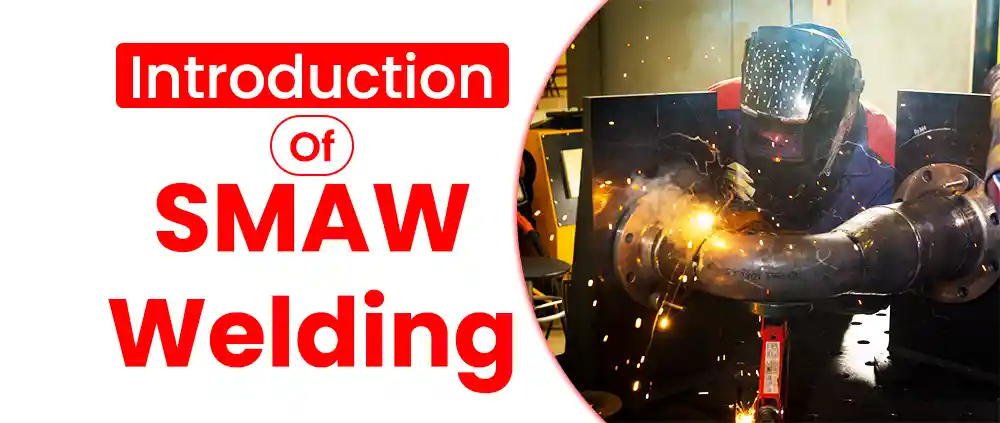Introduction of SMAW Welding:-

Shielded metal arc welding (SMAW), commonly known as stick welding, is one of the oldest and most widely used welding techniques. Developed in the early 20th century, SMAW has stood the test of time and proven itself as a versatile and reliable method of joining metals. In this article, we will explore the principles, equipment, applications, benefits, and challenges associated with SMAW welding.
Principles of SMAW Welding
SMAW welding involves the use of a consumable electrode coated with a flux material. Flux serves several important purposes during the welding process. First, it forms a protective shield around the welding arc, which prevents the molten metal from reacting with the surrounding environment, which can lead to defects. Secondly, the flux produces slag as a byproduct, which coats the newly formed weld bead, protecting it as it cools and solidifies. The slag also acts as an insulator, allowing the welded joint to cool more slowly, reducing the risk of cracking.
Equipment Used in SMAW Welding
SMAW welding requires relatively simple equipment, making it accessible to a wide range of welders, from professionals to hobbyists. The primary components of SMAW equipment include:
Welding Power Source:
A welding machine that generates a direct current (DC) or alternating current (AC) power supply, depending on the electrode used and the metal to be welded.
Electrodes:
These are consumable filler metal rods with a flux coating. They come in a variety of types and sizes, each suited for specific applications and metal types.
Welding Cable:
The heavy-duty cable that connects the welding machine to the electrode holder and workpiece clamp.
Electrode Holder:
A handheld device that holds the electrode securely and allows the welder to manipulate it during welding.
Ground clamp:
The clamp connects the workpiece to the negative terminal of the welding machine, completing the electrical circuit.
Applications of SMAW Welding
SMAW welding finds application in a wide range of industries and scenarios due to its portability, versatility and ability to weld thicker materials. Some common applications include:
PIPING : The Powerful Lifeline of the Oil & Gas Industry in 2023
Construction:
SMAW is used extensively in the construction industry for welding structural steel in buildings, bridges and infrastructure projects.
Fabrication:
It is widely used in metal fabrication shops for making welds on pipes, pressure vessels and heavy machinery components.
Repair and Maintenance:
The SMAW is valuable for on-site repair and maintenance operations where portability and simplicity are essential.
Shipbuilding:
SMAW is a preferred method for welding in shipbuilding, especially for hull and structural components.
Pipeline Welding:
SMAW is used for the construction and repair of pipelines, especially in remote and challenging areas.
Advantages of SMAW Welding
Versatility:
SMAW is suitable for a variety of metals including carbon steel, stainless steel, cast iron and non-ferrous metals.
Portability:
The equipment for SMAW is relatively portable, allowing welding in remote locations or places with limited access to power sources.
Simplicity:
SMAW welding machines are easy to operate, making them accessible to welders of various skill levels.
Cost-effective:
SMAW is more economical than some other welding processes, making it a cost-effective option for specific applications.
All-Position Welding:
The SMAW can be used for all welding positions (flat, horizontal, vertical, overhead), providing flexibility in challenging welding scenarios.
Challenges of SMAW Welding
Despite its many advantages, SMAW has some challenges that welders need to be aware of:
Slag Removal:
The slag generated during SMAW welding needs to be carefully removed after each pass to obtain a quality weld.
Low setting rate:
SMAW generally has a lower setting rate than some other welding methods, which can slow welding progress.
Skill dependent:
SMAW requires more skill and practice to obtain high quality welds than some automated welding processes.
Limited joint penetration:
Achieving deep penetration into thick materials with SMAW can be more challenging than with processes such as gas metal arc welding (GMAW).
Conclusion
Shielded Metal Arc Welding (SMAW) remains a fundamental and widely used welding technique in various industries around the world. Its versatility, portability and all-position welding capability make it a reliable choice for welding professionals and enthusiasts alike. While the SMAW requires skill and practice, its ability to weld a variety of metals and its cost-effectiveness make it a valuable asset in a welding toolkit.
Download Free PDF for Piping Interview Questions